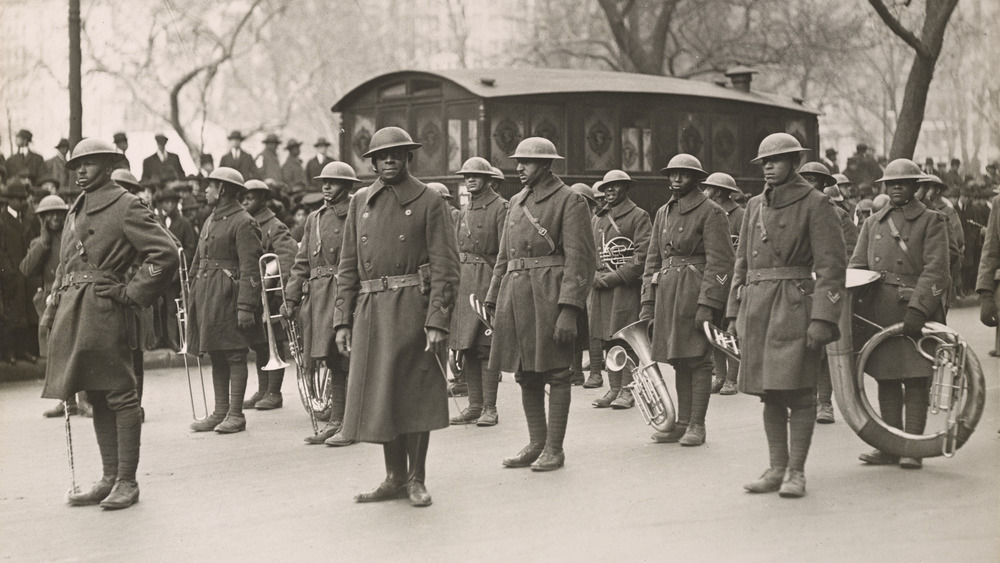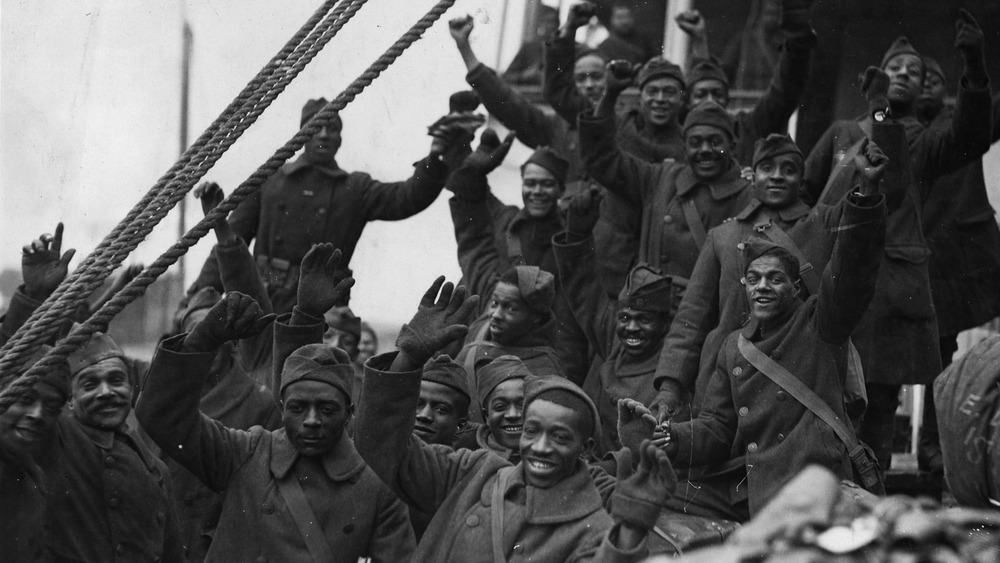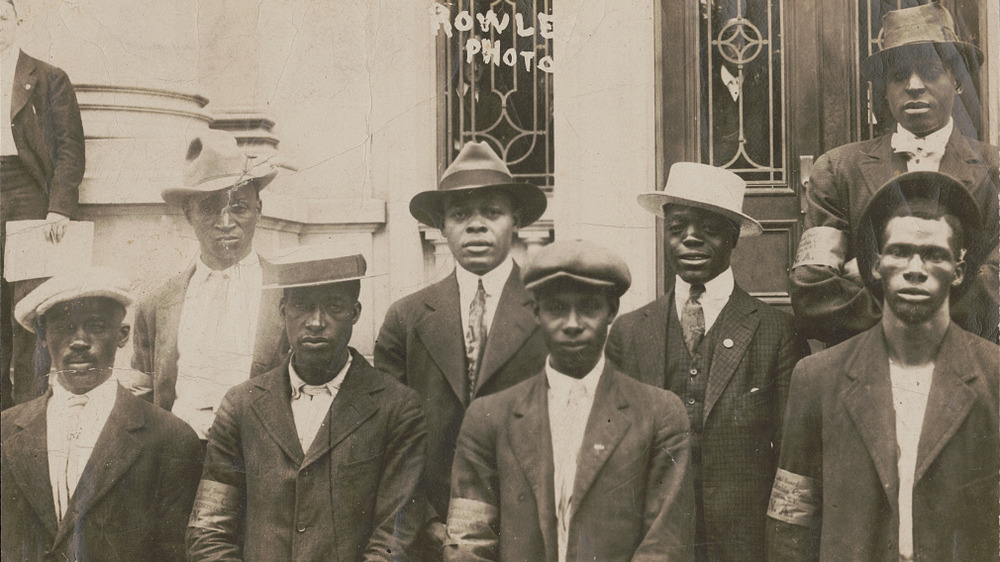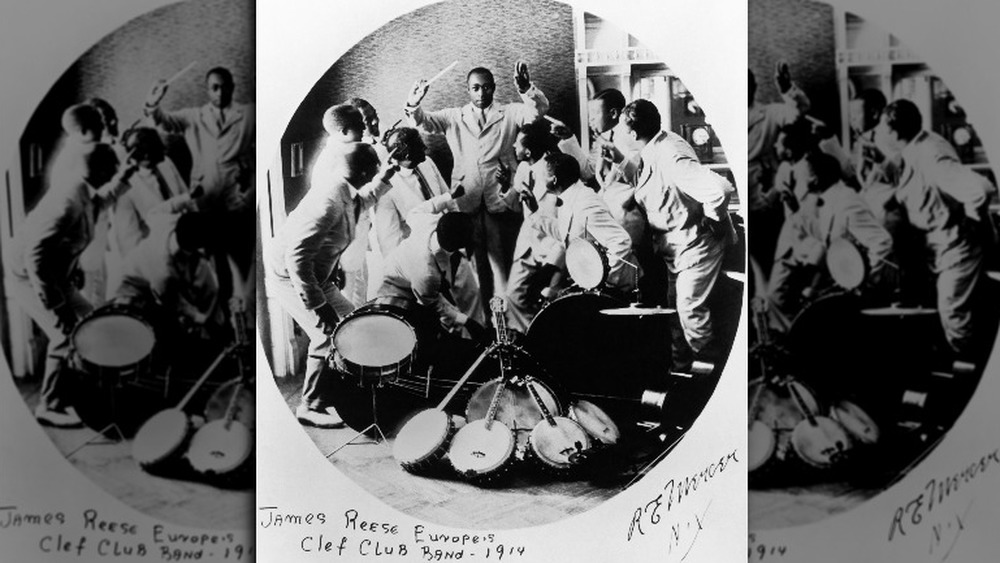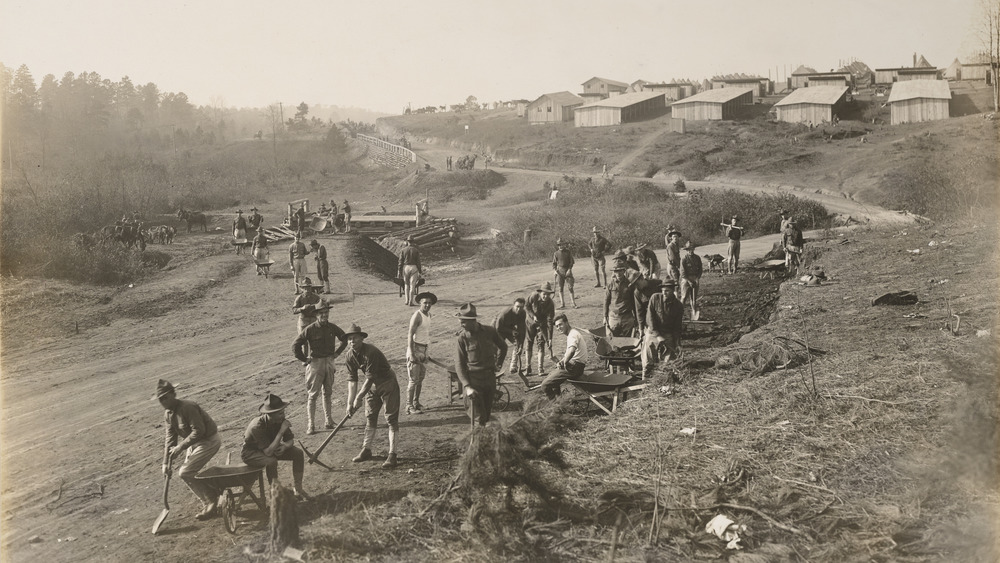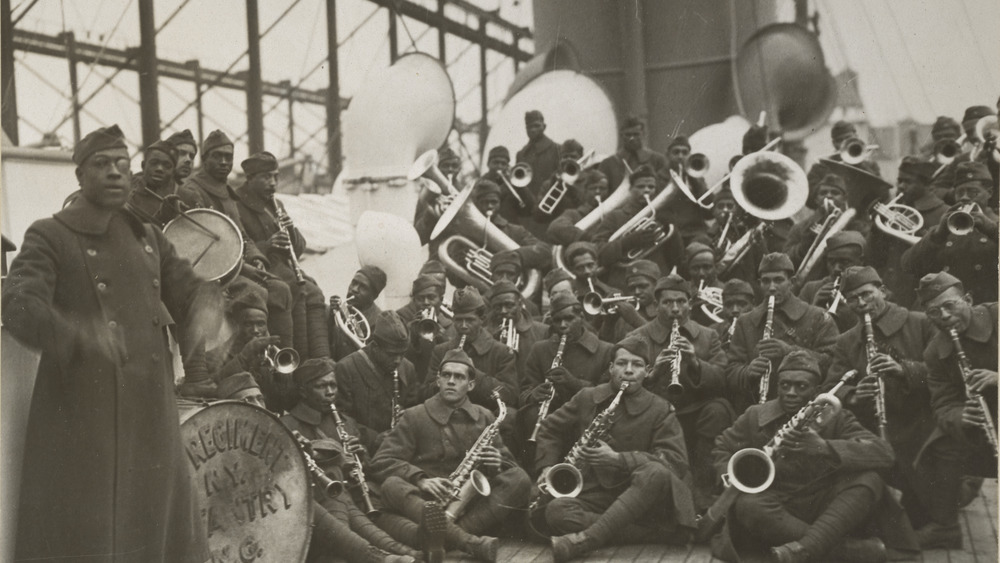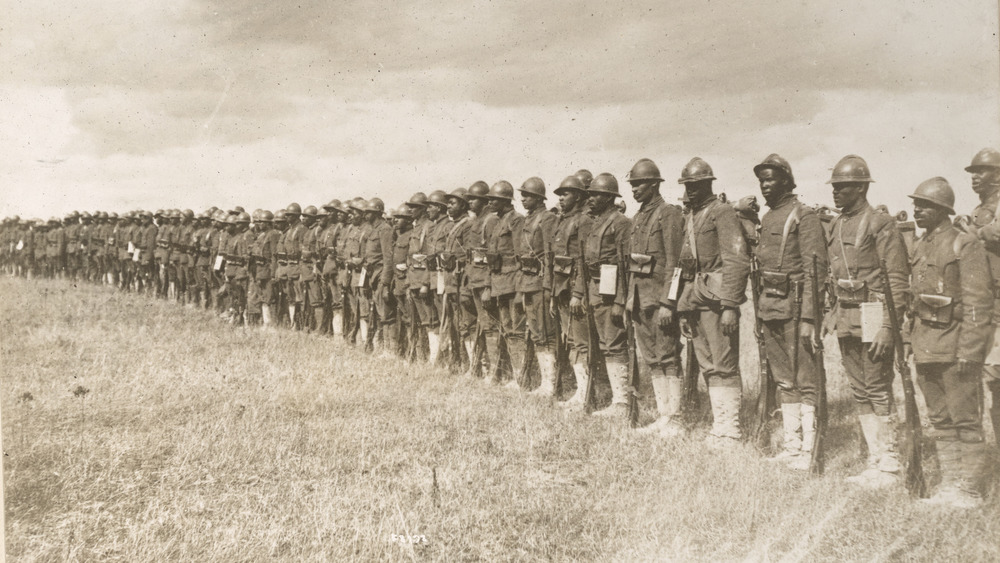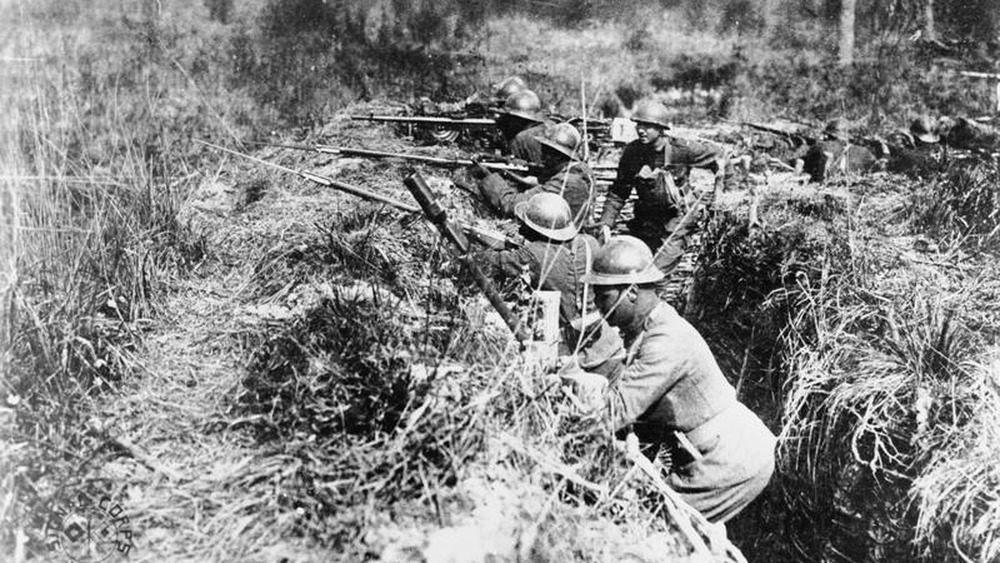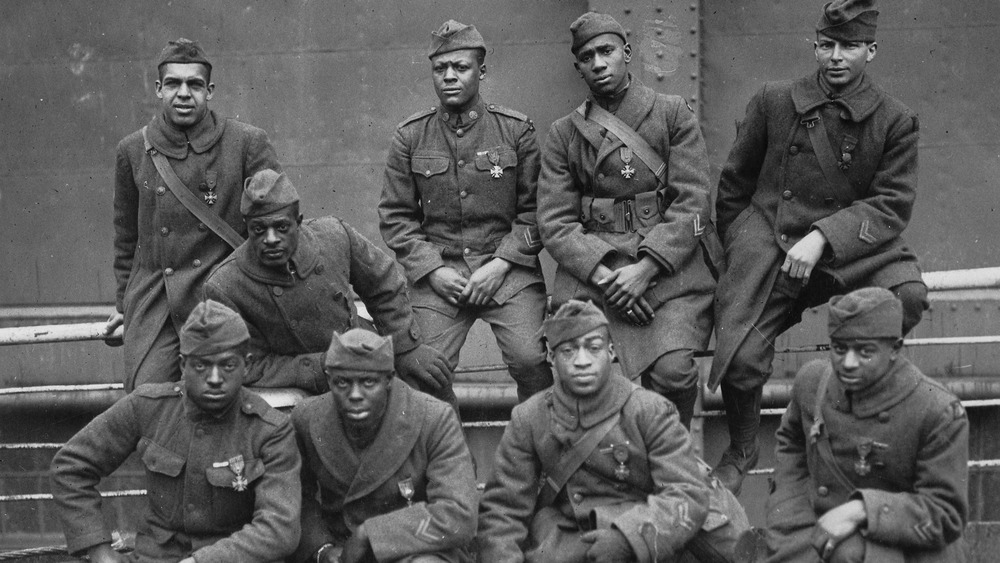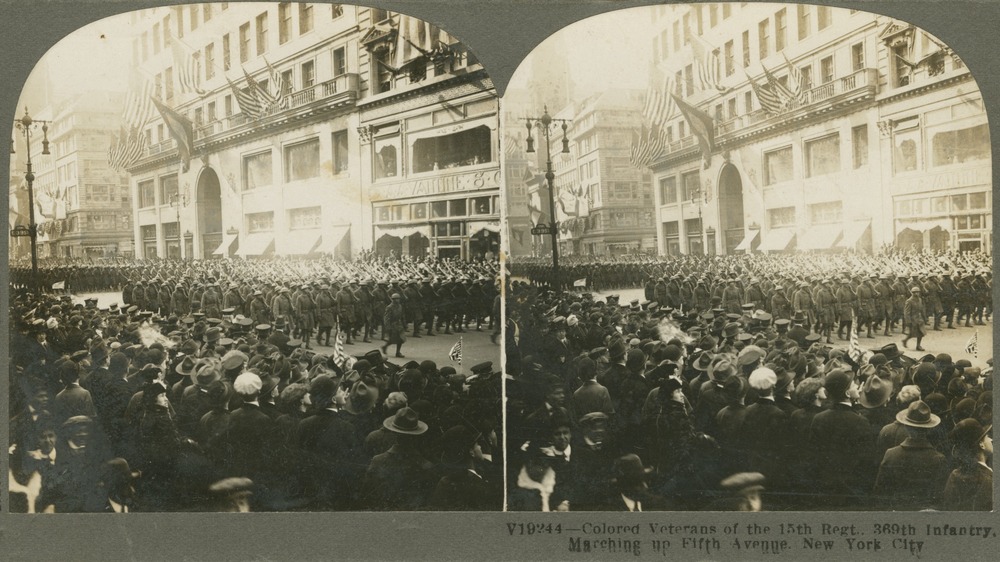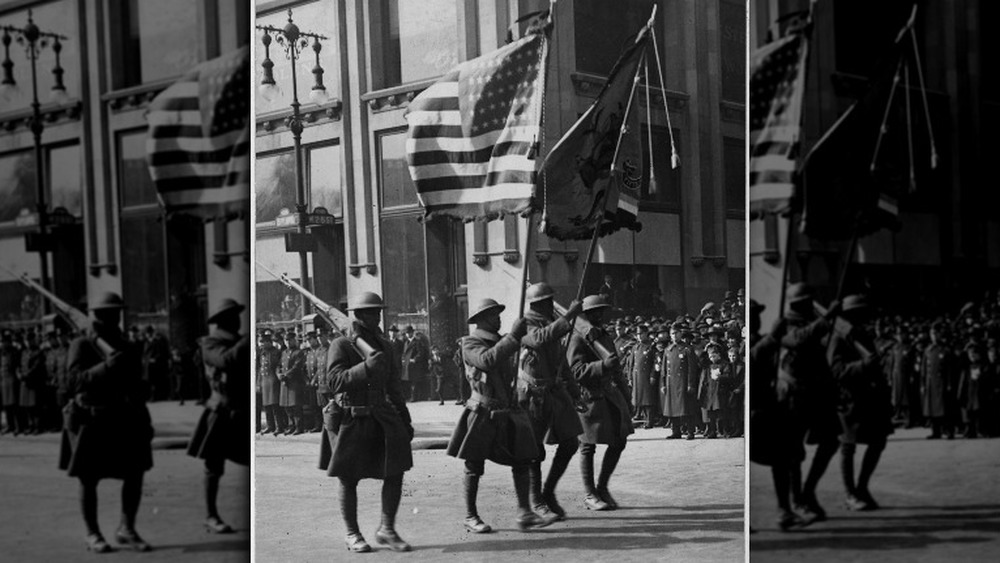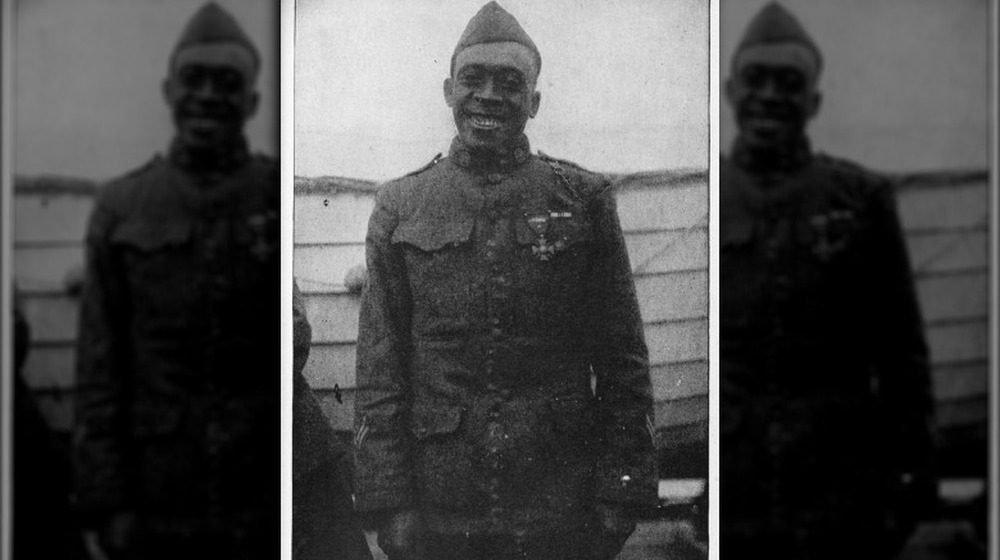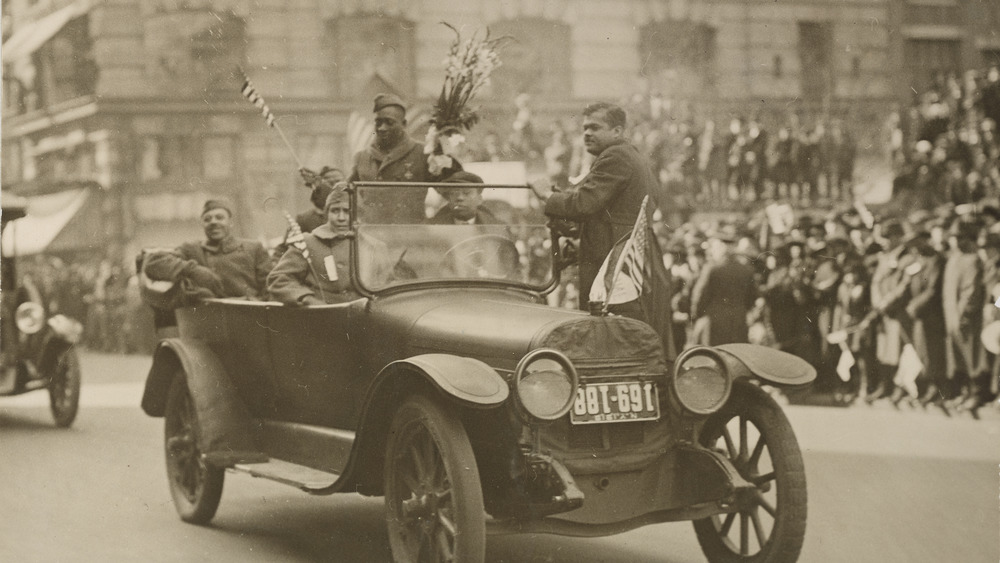The Untold Story Of The Harlem Hellfighters
In February 1919, citizens in New York clamored out onto the edges of Fifth Avenue to attend a massive parade. An armistice agreement had just been signed a few months prior, and millions were there to celebrate the end of the Great War and an Allied victory. Mostly, though, they hoped to catch a glimpse of the troops this homecoming parade was organized for: the famous Harlem Hellfighters.
Started as the 15th New York Infantry Regiment, then reorganized as the 369th Infantry Regiment, the Harlem Hellfighters were one of the first African American National Guard units in the country and later became some of the few Black soldiers to see combat during World War I. Their bravery, resilience, and success on the battlefields over in Europe would make headlines across the Atlantic Ocean, making them some of the most well-known soldiers in America. But after a brief moment of intense recognition, the fame of the Harlem Hellfighters faded all too quickly, and the true circumstances of the legendary regiment have been often overlooked in the war's history until recent years. Here is the untold story of the Harlem Hellfighters.
How the 369th Infantry Regiment became the Harlem Hellfighters
Originally the 15th New York (Colored) Infantry Regiment before they were reorganized as the 369th Infantry Regiment, this group of mostly Black American troops from Harlem would become one of the most famous regiments during World War I, according to Britannica. Their status as the first Black Americans to see combat led to a number of nicknames, as described by the U.S. Army. With a rattlesnake on their crest, they called themselves the "Black Rattlers," and the French they fought alongside referred to them as "Hommes de Bronze," or "Men of Bronze."
Their most famous and long-lasting nickname, however, would be the Harlem Hellfighters. Both astonished by and fearful of their performance and resilience on the battlefield, their German enemies took to calling them "Hollenkampfer," or "Hellfighters." The Harlem Hellfighters' reputation was built on stories of their ferocity in battle, such as when just two troops of the 369th managed to fight off around 20 German soldiers in brutal hand-to-hand combat when their post was attacked, as detailed by Smithsonian Magazine. A Prussian officer once told his American captors: "They are devils. They smile while they kill and they won't be taken alive."
Many were against the regiment even being established
According to Britannica, before being reorganized as the 369th Infantry Regiment during World War I, the Harlem Hellfighters were part of a National Guard unit, the 15th New York (Colored) Infantry Regiment. As the first African American regiment in New York, the 15th's existence was historic but came only after some resistance. For years, some leaders in Harlem's Black community had attempted to establish a local military unit, only to be repeatedly rejected by white politicians. In 1913, a law was passed that finally permitted the creation of a New York African American National Guard regiment, but for years, no action was taken to get the regiment started.
It wasn't until three years and two New York governors later that a commanding officer was finally appointed to begin organizing the regiment in June 1916. Led by former colonel and campaign manager William Hayward, a white man, the 15th New York worked hard to get recruits, even obtaining an endorsement from popular African American newspaper New York Age. Unfortunately, the prospect of military service was not particularly attractive for the Black community, and the regiment struggled for months to get men to enlist.
A celebrity enlistee
After months of failing to meet enlistment goals, the 15th New York received a saving grace in the form of James Reese Europe. A talented composer and bandleader, Europe was one of the biggest names in music, performing at high society events and instrumental to the jazz movement. At the same time, he was passionate about furthering the development and strength of the Black community and saw military service as an opportunity for that. According to Britannica, Europe saw the 15th as a potential institution "for the development of the Negro manhood of Harlem," telling those around him that "our race will never amount to anything, politically or economically, in New York or anywhere else unless there are strong organizations of men who stand for something in the community." At his words, Europe's collaborator, well-known musician Noble Sissle, also joined the regiment.
For a while after their enlistment, the 15th continued to struggle with recruitment until commanding officer William Hayward became inspired by the 8th Illinois, the only other African American National Guard regiment, and its popular concert band. Quickly, he sought out Europe and Sissle, naming them bandleader and drum major of the newly established regimental band that would be used for parades, recruitment, and fundraisers, as described by Smithsonian Magazine. Given generous funding, Europe traveled all across the country and even visited Puerto Rico (according to the BBC) and recruited the best of the best for the 15th New York.
Before the battlefield, the Harlem Hellfighters faced threats in the South
When the United States declared war on Germany, the 15th New York was sent off to various camps for training, according to Britannica. In October 1917, the regiment was sent off to the Jim Crow-controlled South to train at Camp Wadsworth in Spartanburg, South Carolina. Faced with racist threats and harassment on a daily basis in town, the troops were ordered by commanding officer William Hayward to report the instances to military authorities but never retaliate, as described by Smithsonian Magazine. After all, they all knew how easily such incidents could turn fatal. Just two months before they arrived in South Carolina, 20 had died in Houston during a clash between Black soldiers and whites.
Knowing the danger his regiment faced, Hayward met with the Secretary of War to push for the 15th to be relocated or deployed as soon as possible. Ironically, on his way to Washington, the kind of incident he was hoping to avoid nearly broke out. When Noble Sissle stopped by a hotel for a newspaper, he was called a racial slur by the hotel owner. In retaliation, 100 of his fellow soldiers, both white and Black, gathered at the hotel angrily. Luckily, James Reese Europe was able to calm down the situation until military police arrived. Soon after, Hayward's efforts in D.C. proved fruitful, as the 15th was sent back to New York and then deployed to France by the end of the year.
The Harlem Hellfighters introduced jazz to Europe
Beyond their heroism on the battlefield, the Harlem Hellfighters are credited with introducing and popularizing jazz in Europe. According to Smithsonian Magazine, when the troops first arrived in France at a small port town called Brest, they played a jazz version of France's national anthem, "La Marseille," right on the docks. Musician Noble Sissle recalls in his memoir how the French had "an astonished look, quickly alert, snap-into-it-attention, and salute by every French soldier and sailor present." The sounds these instrumentalists were making were so shocking to the French that they even went so far as to examine the Hellfighters' instruments for some kind of tampering or trickery, according to the BBC and Montmartre Artists' Studios.
While Parisians would have been familiar with ragtime music from the Black Americans who'd toured Europe before World War I, jazz was still a relatively unknown genre in Europe before the Harlem Hellfighters arrived. When bandleader Lieutenant James Reese Europe was injured and deemed unfit for combat, he took the Hellfighters band to Paris, where they played for troops and dignitaries, captivating crowds of thousands. In an interview with the New York Tribune, Europe described the mania they inspired: "Everywhere we gave a concert, it was a riot. We played to 50,000 people [at the Tuileries], at least, and had we wished it, we might be playing yet."
The Harlem Hellfighters weren't supposed to be fighting at all
The fact that the Harlem Hellfighters even fought in the war was actually an unusual circumstance. According to Britannica, when the regiment first arrived in France, they were assigned to engineering projects heavily involving labor in order to prepare for the bigger wave of troops coming. These types of roles were the norm. Rather than have Black soldiers integrated along the front lines in combat, the Army typically limited them to labor and service units. These units would perform backbreaking work that was essential to the war effort, such as "digging trenches, removing unexploded shells from fields, clearing disabled equipment and barbed wire, and burying soldiers killed in action," as described by Military.com. Incentivized with "special privileges in return for high-yield results," the troops would often work for 24 hours at a time.
The Harlem Hellfighters were part of the 11 percent of Black soldiers who saw combat during World War I, according to PBS. Part of the reason why was because of their commanding officer, William Hayward, who saw his soldiers' fighting spirit depleting. Hayward, taking advantage of the regimental band's popularity, worked to convince General Pershing, who was in charge of the American Expeditionary Force, to reassign the 369th to combat duty.
The Harlem Hellfighters saw more combat than any other Americans in the war
As told by Smithsonian Magazine, the American troops in France were meant to fight as a force independent from the French and British troops already stationed there. The directive came straight from President Wilson, who wanted "to preserve troop morale and accountability for American casualties and to strengthen [his] clout in eventual peace talks." But the reality on the front lines was that the French and British were desperate for reinforcements, and when the French begged the U.S. for more men, General Pershing made an exception to the president's order by sending over the 369th Infantry Regiment, as the French had already deployed Black soldiers to combat in the past, according to Military.com. The 369th's commanding officer, William Hayward, who had been advocating for his men to see combat, saw the irony in the assignment: "We are now a combat unit... Our great American general simply put the black orphan in a basket, set it on the doorstep of the French, pulled the bell, and went away."
Donning French uniforms and being trained with their forces, the 369th entered the trenches over a month before the American forces had their first major battle. As a result, the Harlem Hellfighters spent 191 days on the front lines, more time than any other American regiment did during World War I. And while they emerged victorious, they also experienced some of the worst losses of any American regiment, with 144 killed and nearly 1,000 wounded.
The Harlem Hellfighters received the most honors in World War I
For their unparalleled heroism during the war, the Harlem Hellfighters became the most decorated American regiment of World War I. The French, who they had fought alongside in the trenches, honored the entire 369th regiment with the Croix de Guerre, with 171 men receiving individual medals for their gallantry, making them the first Americans to ever receive the honor, according to ThoughtCo and the National Archives. The U.S. Army also awarded some Harlem Hellfighters with the Distinguished Service Cross.
One of the most famous and decorated Hellfighters was Henry Johnson, one of two men who famously fought back 20-some German soldiers when they launched an attack trying to advance over the French line. His actions made him well-known upon his homecoming, and, decades later, after his death, he would receive the Purple Heart in 1996, the Distinguished Service Cross in 2002, and America's Medal of Honor in 2015, as written by the U.S. Army and the White House Archives.
A tale of two parades
Parades were a common event in this era of war. Farewell parades were held for troops being deployed, and homecoming parades were thrown to celebrate the end of bloodshed. For the Harlem Hellfighters, the parades showed to them the stark difference in the way they were treated, a difference that exemplified just how much Black Americans had to achieve in order to get a semblance of the respect that white Americans did.
According to Britannica, in December 1917, a farewell parade was organized in New York City for the "Rainbow" Division, a group of National Guard units from almost 25 states. The Harlem Hellfighters, who, at the time, were called the 15th New York, were explicitly banned from attending the parade that was being held in their own city. The reasoning was plain racism, with the men being told that "black is not a color in the rainbow." Fast-forward just over a year later to February 1919, and the Harlem Hellfighters, now famous for their unparalleled efforts in the Great War, were the main heroes of their own massive homecoming parade where there were up to five million in attendance, as described by ThoughtCo.
With recognition came a spike in racial violence
While the Harlem Hellfighters may have initially received a warm welcome home, the praise and recognition they enjoyed would soon be overshadowed by a spike in racial violence as those determined to maintain the racist status quo lashed out. According to Military.com, as Black troops began returning to the United States in early 1919 once the war ended, white Americans began to fear the idea of Black veterans using their hero status and military training to demand equality at home.
As a result, in the summer and fall of 1919, anti-Black race riots occurred in 26 cities all across the country. Violent crimes against the Black community spiked, with the number of lynchings seeing a 33-percent year-on-year increase to a total of 77 in 1919. Even those servicemen who had fought in the war were not spared, with at least ten victims being veterans. In fact, there were even those who were lynched wearing their uniform.
Henry Johnson: a war hero too quickly forgotten
When Henry Johnson returned home after the end of the war, he was one of the most famous American soldiers of the time. Legendary for his actions on the battlefield, Johnson was the "Black Death" that managed to prevent roughly 20 Germans from overtaking the French line in the Argonne Forest, as told by Smithsonian Magazine. On duty with fellow soldier Needham Roberts, who quickly became wounded from a grenade, Johnson ended up single-handedly killing four enemies and injuring 10 to 20 more. When he was later praised for his performance on the battlefield, Johnson replied, "There wasn't anything so fine about it. Just fought for my life. A rabbit would have done that."
For a brief time, the famed Johnson went into public speaking, but according to Smithsonian Magazine, "after a fiery speech in St. Louis in March 1919, in which he accused white soldiers of racism and cowardice, Johnson disappeared from the public sphere." To make matters worse, despite suffering 21 wounds in the Argonne Forest, his records somehow showed no injuries, leaving Johnson ineligible for a Purple Heart and with no disability allowance. The forgotten hero would struggle for ten years before dying in his thirties in 1929.
Almost a century later, as his story resurfaced among historians and political leaders, Henry Johnson would be recognized posthumously for his bravery, receiving the Purple Heart, Distinguished Service Cross, and the Medal of Honor.
It took over 100 years for the nickname to become official
Despite the fact that the 369th regiment had been referred to as the Harlem Hellfighters since the years of World War I, it wasn't until 2021 that the nickname was actually made official. According to the U.S. Army, there is an official list of over 700 "Army, Army National Guard, and Army Reserve units [...] which have official special designations." But when a museum director referred to this list looking for the "certificate noting the official designation of the 369th as the Harlem Hellfighters" in 2019, he came up empty-handed.
The error, it turned out, stemmed from the simple problem of official paperwork. In all the years that the 369th had been known as the Harlem Hellfighters, no one had thought to go in to submit a written request to the National Guard Bureau make it official, perhaps because everyone just assumed it already was! Luckily, once the issue was pointed out, the process to make the nickname official quickly began, which involves doing research and proving that the designation had been used for at least 30 years, a fairly easy feat for the famous Harlem Hellfighters. With the process of putting the right documents together taking about a year, the 369th was officially designated as the Harlem Hellfighters in February 2021, over 100 years after they earned the moniker during World War I.
